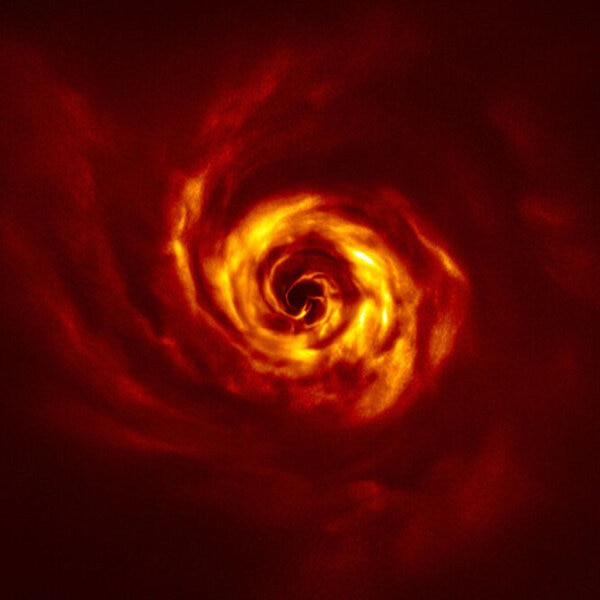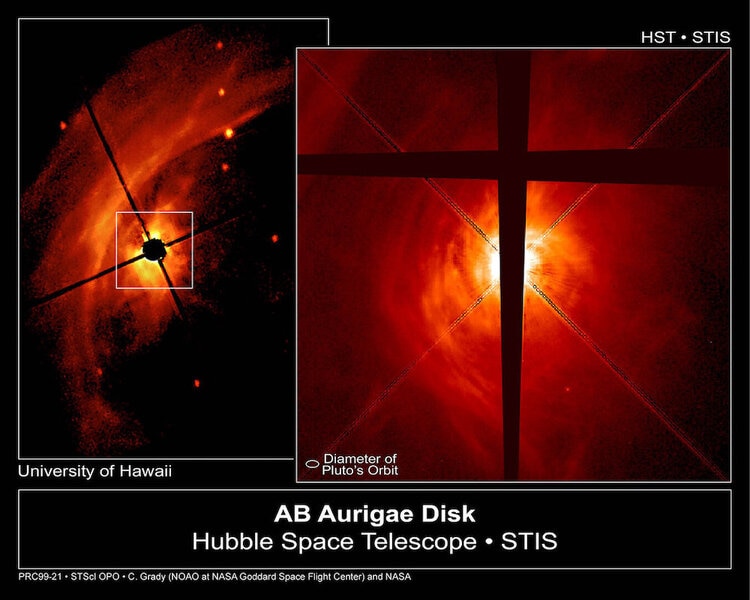Create a free profile to get unlimited access to exclusive videos, sweepstakes, and more!
Psst! Wanna see an actual Hubble image of a planet forming around a nearby star?
Theorized exoplanet AB Aurigae b now directly seen in photos.

We now know of over 5,000 exoplanets, worlds orbiting other stars. The vast majority of those were discovered via the transit method, where the planet causes a mini-eclipse and blocks a little bit of its host star’s light. This is an indirect method; we don’t see the planet itself, just the effect it has on its star’s light.
As of right now, fewer than 60 exoplanets have been directly imaged; that is, seen in actual images taken of their star. This method works best looking in infrared light with young stars — newly formed planets glow in IR due to their own heat, while stars tend not to emit as much infrared, making the planets easier to spot. This also works best for planets that are pretty far from their star — 50-300 times farther out than Earth is from the Sun — so they aren’t lost in the glare.
This can work for even younger planets too. So young, they’re still forming.
AB Aurigae is a young star, 2-4 million years old, and is about 560 light-years from Earth. It’s more massive, hotter, and brighter than the Sun, and is what we call a pre-main-sequence star, not quite yet fusing hydrogen and helium in its core, but very close.
It’s surrounded by the dust and gas from which it formed. There’s a ring of dust seen in millimeter wavelengths by ALMA that’s about 18 billion kilometers out from the star, and a flat disk of gas much closer in. The gas disk has spiral arms in it, which theoretical models show could indicate a planet or brown dwarf — an object intermediate in mass between a planet and star — in there, its gravity disturbing the gas in the disk. The dust ring also cuts off abruptly on its inside edge; another indicator of a decently massive body orbiting the star, its gravity truncating the inner ring.
With that in mind, a team of astronomers used the huge Subaru telescope in Hawaii and Hubble Space Telescope to look for any possible still-forming planets, called protoplanets, orbiting AB Aurigae.
And it looks like they found one.
A bright spot is seen a small distance away from the star, roughly 90 times the Earth-Sun distance, or about 14 billion kilometers out — a bit over twice as far as Pluto from the Sun. It’s outside the main disk of gas but inside the dust ring.
AB Aur moves slowly in our sky relative to more distant objects, and if this spot were a background star or galaxy it would be at a very different position in the images after 15 years. It was seen in infrared observations taken by Hubble in 2007, and is still in nearly the same position relative to the star in new observations. It’s also seen in images taken with the Subaru telescope, so it’s not due to some telescope or processing artifact. It’s real, and it moves along with the star.
Not only that, over the time between images the spot is seen to move a little bit around the star, consistent with it orbiting the star at that distance in a counterclockwise direction. That would be true for a protoplanet as well as for just some large clump of gas, so that’s interesting but not conclusive.
Better, though: Its position matches theoretical predictions of where a massive protoplanet should be to explain the spiral features in the gas disk, which is exciting.
It’s also clearly not a point source, not a simple dot, in the images. Its size implies it’s at most about 2 billion kilometers across, which is huge. However, if a still-forming planet is at that distance from its star and has a mass of about 4 times Jupiter’s mass, it would have a disk of material surrounding it that would be about that size. So again, this is consistent with a massive protoplanet.
If this were just a blob of dust orbiting the star, the light we see from it would be highly polarized; that is, the waves of light would be strongly aligned. This is not seen, indicating the light is coming from the object itself and not just from reflected light. In other words, it’s glowing. Also, it’s seen in the kind of light emitted by excited hydrogen gas, which is expected for a planet surrounded by gas that’s falling into it.
The colors of the spot also are consistent with it being a massive but still very hot planet. Using theoretical models, the best fit the astronomers got was for a young planet about 9 times Jupiter’s mass, 2.75 times its diameter — pretty big, but that’s because its still forming and hasn’t settled down yet — and with a temperature of about 2,000° C. Super hot, but again that’s expected. That matches an accretion rate — how quickly matter is falling on it — of about a millionth of Jupiter’s mass every year. That may not sound like much, but Jupiter is a beast. That accretion rate is equal to 5,000 trillion tons per day.
That’s 66 billion tons per second. Per second. That’s like a 4-kilometer-wide asteroid — roughly half the diameter of the dinosaur killer — impacting the protoplanet every single second of every day of every year, for hundreds of thousands of years. No wonder it’s glowing hot.
Having said all this, this isn’t conclusive proof it really is an accreting protoplanet, but it’s pretty dang convincing evidence.
That makes me very happy. As I’ve written before, back in the day I worked on the 1999 Hubble observations of this star. This potential protoplanet was too close to the star to be seen in our data, but the new observations were done in a different way that allowed the planet to be teased out of all the light from the star. Impressive.
And it’s so close to us! We see stars forming all over the Milky Way, all the time, and this is yet another piece of the galactic puzzle that shows that planets form right along with them. The Universe is filled with planets, worlds beyond counting, and we’re just getting started finding them.
Tip o’ the dew shield to Thayne Currie, lead author on this research, for alerting me to his work.






























